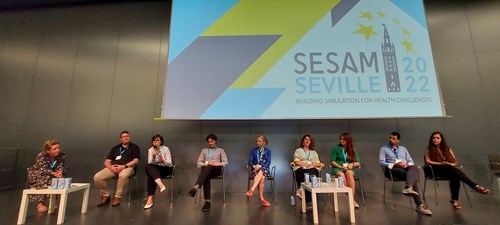
SIMU at SESAM 2022
We draw further inspiration and are honoured to be able to pass on our experience around the world. For example, at the SESAM Congress in Seville, Spain.

Approximately 750 delegates attended this year's Society for Simulation in Europe Congress in Seville, Spain. The congress featured, among other things, 9 key note presentations and 42 workshops, which together with the other programmes, made a total of 112 hours of professional communication. The Department of Simulation Medicine of the Faculty of Medicine of the Medical Faculty of Masaryk University was represented by: doc. MUDr. Martina Kosinová, Ph.D., MUDr. Tereza Vafková, MUDr. Tamara Skříšovská, MUDr. Matěj Anton and MUDr. Daniel Barvík. In the following lines, we will guide you through the active communications of this team, as well as the interesting lectures and workshops in which they participated.
Cecilia Berlin opened the Congress with her key note lecture. In her presentation entitled "The stakeholders of workplace design change: why they matter and how to find them", she focused on workplace design in general and the human factor and its mistakes in particular. In addition, she presented a tool called CHAI – Change Agent Infrastructure, which is suitable for understanding and adapting work processes not only in healthcare and education.
During the first day of the conference, there was also a talk on teaching first aid and also gynaecology and obstetrics at SIMU. The topics "New approach in First aid undergraduate training" and "Establishing Student as Teacher programme for First aid undergraduate training" were presented by MUDr. Tereza Vafková. "Curriculum development for undergraduate education of obstetrics and gynaecology" was then presented by MUDr. Matěj Anton. Both lecturers subsequently participated in the ongoing panel discussion within the "Faculty and curriculum development" block.
This was followed by a workshop by Walter Eppich "Telling a Compelling Story to Publish your Ideas and Research: Academic Writing". The workshop showed how to write an article in a way that is easy to grasp for the editor and the potential reader. Walter showed us one of his articles before and after taking a similar workshop. The difference was clear. His text after editing was easy to read, he showed right at the beginning what problem was being addressed, where the knowledge gap was and why it was important to close this knowledge gap (problem-gap-hook).
In the meantime, Jose Maestre also held a workshop on the concept of "Circle Up", which translates the concept of briefing and debriefing, familiar from simulations, into everyday clinical life. It is a system of peer support, and building psychological resilience of healthcare workers with the effect of improving the safety of patient care.
Another very interesting paper was presented by obstetrician Oscar Martinez Perez and midwife Rita Salvador Lopez from Puerta de Hierro University Hospital. It concerned the formation and results of a working group that set itself the task of eliminating birth trauma to the brachial plexus of the new-born, which occurs through improper assistance during labour for shoulder dystocia. The task force has established a system of education through hands-on training with very good results.
On the second day of the conference in Seville, the SIMU team did not slack off and presented two more communications. MUDr. Tamara Skříšovská presented a short communication on "Digging deeper into the medical errors" and doc. MUDr. Martina Kosinová, Ph.D. presented a paper entitled "First-year of High-fidelity simulations in postgraduate training in a new Simulation Centre". Both presentations were based on postgraduate courses that have been available at SIMU for more than a year.
The key note lecture of the day was given by Hege Ersdal with "Data-driven quality improvement – adjusting simulations to address gaps in clinical care. Safer Births at scale". In her presentation, she presented a more than 10-year project to support mothers and new-borns in Tanzania. She also explained why simulation training alone outside of the delivery room setting may not be enough to change practice, although it has been very successful on its own.
The workshop on SitBox methodology consisted in introducing this complement to high-fidelity simulation. A SitBox is a concept of a short story accompanied by visual or audio documentation that relates to a follow-up simulation. Each box includes two to three general questions that prompt students in their decision-making process before the simulation itself. For our purposes, the SitBox could be used, for example, in home preparation for courses.
Prashant Kumar's workshop entitled "Co-debriefing in interprofessional simulation-based education interactive workshop" introduced us to the benefits and challenges in interprofessional debriefing setup. One of the main take-home messages during the discussion was that interprofessional debriefing starts with the interprofessional development of the simulation scenario and protocol.
The third day continued with Walter Eppich's second workshop entitled "Thinking qualitatively about educational research". Here, he explained how he believes research in simulation medicine can be approached qualitatively. Optimally, that is, so that we can understand the issue and not just put it into numbers, as we are used to from a quantitative approach. He also mentioned what the structure of the text should be and what he, as an editor, most appreciates in evaluated articles.
Thanks to the many interesting and stimulating presentations, the three days of the Congress passed very quickly. At the end, the date and location of next year's SESAM conference was presented. We look forward to 14–16 June 2023 in Lisbon, Portugal!






